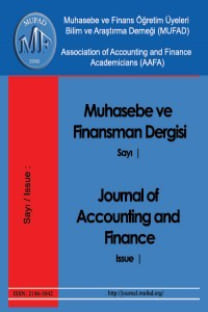Riskten Korunma Muhasebesi Ve Türkiye'de Uygulanabilirliği Üzerine Bir Vaka Çalışması
1972 yılında Bretton Woods anlaşmasının sona ermesi ve serbest kur sistemine geçilmesi ile finansal riskler ön plana çıkmıştır. Özellikle küreselleşme ile birlikte uluslararası piyasalarda yaşanan gelişmeler risklerin çeşitlenmesine ve kapsamının artmasına neden olmuştur. İşletmelerin maruz kaldıkları risklerin artması ve faaliyet sonuçlarını olumsuz yönde etkilemesiyle birlikte bu riskleri yönetme ihtiyacı ortaya çıkmış ve günden güne daha da önemli hale gelmiştir. Günümüzde finansal risk yönetiminde en çok kullanılan yöntemlerin başında hedging olarak adlandırılan riskten korunma gelmektedir. Risktenkorunma kapsamında gerçekleştirilen işlemler işletmelerin finansal tablolarında dalgalanmalara sebep olabilmektedir. Bu durumu ortadan kaldırmak amacıyla riskten korunma muhasebesi uygulanmaktadır. Bu çalışma ile Uluslararası Muhasebe ve Finansal Raporlama Standartları (UMS/UFRS) kapsamında riskten korunma muhasebesi teorik olarak incelenmiş ve Türkiye’de faaliyet gösteren bir şirketin riskten korunma muhasebesi uygulamasına yer verilerek sürecin irdelenmesi ve farklı şirketler adına yol gösterici olması amaçlanmıştır.
A Case Study On Hedge Accounting and Its Applicability in Turkey
In 1972, financial risks have come to the forefront with the end of the Bretton Woods agreement and the transition to floating exchange rate system. Especially with the globalization, developments in international markets have caused these risks to increase and diversify scope. With the increasing risks that businesses are exposed to day by day and adversely affecting their operational results, the need to manage these risks has emerged and has become even more important day by day. Nowadays derivative financial instruments are one of the most widely used means for risk management. The diversification of these means in accordance with every need increases the use of these instruments within the scope of risk management. However, with the increase in the use of derivative financial instruments, it has raised the question of how these financial instruments should be reported in the financial statements.In this study, risk management has handle and the use of derivative financial instruments within this scope has explained in accordance with the relevant standards and revealed how to report in accordance with International Accounting and Financial Reporting Standards (IAS / IFRS). In addition, in the scope of application part of this study of the process bygiving the place a thorough study of a company incorporated in Turkey has intended to be scrutinized and guidanced on behalf of different companies.
___
- Abdel-khalik, A. Rashad (2014), Accounting For Risk, Hedging, And Complex Contracts, Routledge, NY.
- Bolak, Mehmet (2004), Risk ve Yönetimi, Birsen Yayınevi, İstanbul.
- D'Arcy, Stephen P. (2001), “Enterprise Risk Management”, Journal of Risk Management of Korea, C.12, S.1, pp. 207-228.
- Demir, Volkan (2015), TFRS/UFRS Kapsamında Finansal Araçlar, Nobel Akademik Yayın, İstanbul.
- Epstein, Barry J.- Jermakowicz, Eva K. (2010), 2010 Interpretation and Application of International Financial Reporting Standards, John Wiley & Sons, UK.
- Frestad, Dennis – Leif, Atle Beisland (2015), ‘‘Hedge Effectiveness Testing as a Screening Mechanism for Hedge Accounting: Does It Work?’’, Journal of Accounting Auditing & Finance, 30 (1), pp.35-56.
- KGK (2017), Finansal Araçlar Standardına İlişkin Türkiye Finansal Raporlama Standardı (TFRS 9) Hakkında Tebliğ, 19 Ocak 2017 tarihli ve 29953 sayılı Resmi Gazete.
- Kızılboğa, Ruveyda (2012), ‘‘Risk Yönetimi ve Ülke Uygulamalarında Risk Yönetim Modelleri’’, Akademik Araştırmalar ve Çalışmalar Dergisi, Yıl 4, Sayı 7, ss. 82-99.
- Mirza, Abbas Ali – Graham, J. Holt - Orrell, Magnus (2006), IFRS Workbook and Guide International Financial Reporting Standards, John Wiley & Sons, UK.
- Ramirez, Juan (2007), Accounting for Derivatives Advanced Hedging Under IFRS, John Wiley & Sons, UK.
- Ramirez, Juan (2015), Accounting for Derivatives: Advanced Hedging under IFRS 9, John Wiley & Sons, UK.
- Sayılgan, Güven (1995), Finansal Risk Yönetimi, Siyasal Bilgiler Fakültesi Dergisi, 1995, c. 50(1), ss.323-334.
- Treanor, Stephen D.- Carter, David A. – Rogers, Daniel A.- Simkins, Betty J. (2013), ‘‘Operational and Financial Hedging: Friend or Foe? Evidence from the U.S. Airline Industry’’, Journal of Accounting and Finance, Vol. 13 (6), pp.64-91.
- Usta, Öcal (2005), İşletme Finansı ve Finansal Yönetim, Detay Yayıncılık, Ankara.
- Yalçın, Erhan (2015), Uluslararası Finansal Raporlama, Seçkin Yayıncılık, 2015, Ankara.
- ISSN: 2146-3042
- Yayın Aralığı: Yılda 4 Sayı
- Başlangıç: 2005
- Yayıncı: Muhasebe ve Finansman Öğretim Üyeleri Derneği (MUFAD)
